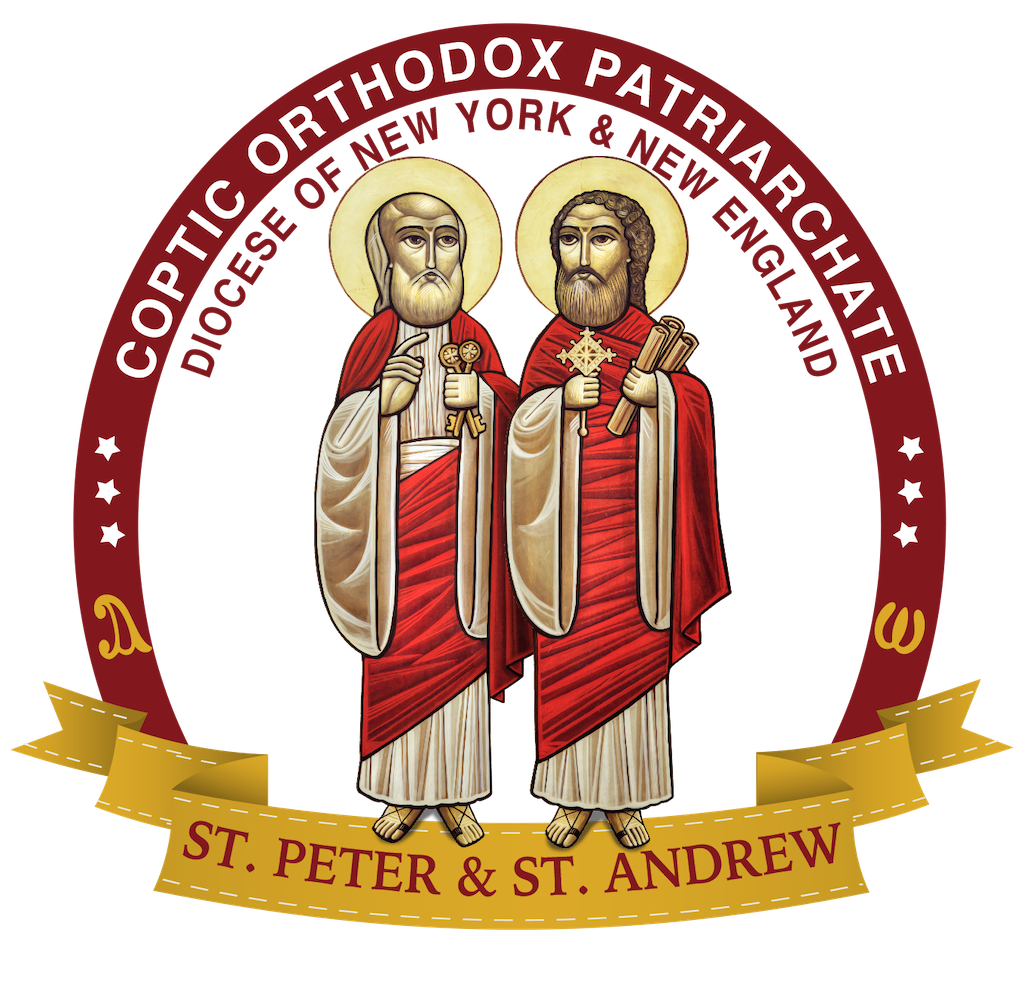The Coptic Church
The Coptic Orthodox Church is one of the most ancient Churches of the world, founded by Saint Mark the Apostle. The Coptic Orthodox Church is a conservative Church that has carefully preserved the Orthodox Christian Faith in its earliest and purest form, handing it down from generation to generation, unaltered and true to the Apostolic doctrines and patterns of worship.The Copts are the Egyptian Christians. They are the successors of the ancient Egyptians “The Pharaohs”. They played a vital role in the whole Christian world, especially during the first five centuries. The word ‘Copt’ is derived from `gypt’ which stems from the Greek word Aigyptos’ meaning `Egyptian’.
The Coptic Church or the Church of Alexandria is called “See of St. Mark”, one of the earliest sees: Jerusalem, Antioch, Alexandria and Rome. The Coptic Church is headed by the Pope of Alexandria, Pope Tawadros II, the 118th successor of St. Mark.
The church faith is based on the teachings of Saint Mark the Evangelist, one of the seventy disciples, and the writer of one of the four Gospels, who brought Christianity to Egypt during the reign of the Roman emperor Nero in the first century, a few years after the Lord’s Ascension. When Saint Mark entered and walked through the streets of Alexandria, a famous city in Egypt, his sandals were torn. While Ananias the cobbler was mending Saint Mark’s shoes, his finger was cut from the awl and he cried out: “O the one God!” Saint Mark healed the cobbler’s finger and spoke to him about who the “One God” really was. Ananias invited Saint Mark to his home where he and his household were baptized after having professed their belief in the Christian Faith. Soon afterwards, many others believed and Ananias’s house became the meeting place for the faithful people.
In 62 AD, Saint Mark decided to leave Egypt to visit the new believers he had preached in the Pentapolis. Before leaving, he ordained Ananias as bishop. He also founded a church in the Crypt where the Holy Family had taken refuge, thus fulfilling the prophesy of Isaiah: “In that day there will be an altar to the Lord in the midst of the land of Egypt, and a pillar to the Lord at its border… Then the Lord will be known to Egypt, and the Egyptians will know the Lord in that day” (Isaiah 19:19,21).
The Coptic Orthodox Statement of Faith: “The Nicene Creed”
We believe in one God, God the Father, the Almighty, Who created heaven and earth, and all things, seen and unseen.
We believe in one Lord Jesus Christ, the Only-Begotten Son of God, begotten of the Father before all ages; Light of Light, true God of true God, begotten not created, of one essence with the Father, by Whom all things were made; Who for us, men, and for our salvation, came down from heaven, and was incarnated of the Holy Spirit and of the Virgin Mary, and became man. And He was crucified for us under Pontius Pilate, suffered and was buried. And on the third day He rose from the dead, according to the Scriptures, and ascended into the heavens; and sat at the right hand of His Father, and also He is coming again in His glory to judge the living and the dead, whose kingdom has no end.
Yes, we believe in the Holy Spirit, the Lord, the Life-Giver, Who proceeds from the Father, Who, with the Father and the Son, is worshipped and glorified, Who spoke in the prophets. And in one holy, catholic and apostolic church. We confess one baptism for the remission of sins.
We look for the resurrection of the dead, and the life of the coming age. Amen.
St. Mark the Apostle, the Founder of the Coptic Church
The Coptic Church or the Church of Alexandria is called “Sees of St. Mark”; one of the earliest four sees: Jerusalem, Antioch, Alexandria, and Rome.
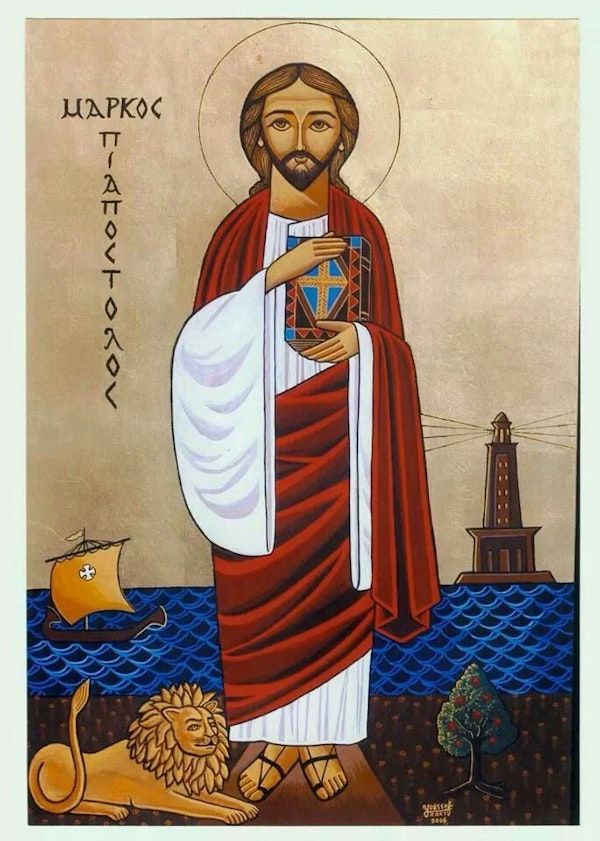
St. Mark, The Founder
The Copts are proud of the apostolicity of their Church, whose founder is St. Mark; one of the seventy Apostles (Mk 10:10), and one of the four Evangelists. He is regarded by the Coptic hierarchy as the first of their unbroken 117 patriarchs, and also the first of a stream of Egyptian martyrs. This apostolicity was not only furnished on grounds of its foundation but rather by the persistence of the Church in observing the same faith received by the Apostle and his successors, the Holy Fathers.
St. Mark’s Bibliography
St. Mark was an African native of Jewish parents who belonged to the Levites’ tribe. His family lived in Cyrenaica until they were attacked by some barbarians, and lost their property. Consequently, they moved to Jerusalem with their child John Mark (Acts 12:12, 25; 15:37). Apparently, he was given a good education and became conversant in both Greek and Latin in addition to Hebrew. His family was highly religious and in close relationship with the Lord Jesus Christ. His cousin was St. Barnabas and his father’s cousin was St. Peter. His mother, Mary, played an important part in the early days of the Church in Jerusalem. Her upper room became the first Christian church in the world where the Lord Jesus Christ Himself instituted the Holy Eucharist (Mk 14:12-26). Also, this is the same place where the Lord appeared to the disciples after His resurrection and His Holy Spirit came upon them.
Young Mark was always associated with the Lord, who choose him as one of the seventy. He is mentioned in the Holy Scriptures in a number of events related with the Lord. For example, he was present at the wedding of Cana of Galilee, and was the man who had been carrying the jar when the two disciples went to prepare a place for the celebration of the Passover (Mk 14:13-14; Lk 22:11).
St. Mark and The Lion
The voice of the lion is the symbol of St. Mark for two reasons:
He begins his Holy Gospel by describing John the Baptist as a lion roaring in the desert (Mk 1:3).
His famous story with lion, as related to us by Severus Ebn-El-Mokafa: “Once a lion and lioness appeared to John Mark and his father Arostalis while they were traveling in Jordan. The father was very scared and begged his son to escape, while he awaited his fate. John Mark assured his father that Jesus Christ would save them and began to pray. The two beasts fell dead and as a result of this miracle, the father believed in Christ.”
Preaching with the Apostles
At first, St. Mark accompanied St. Peter on his missionary journeys inside Jerusalem and Judea. Then he accompanied St. Paul and St. Barnabas on their first missionary journey to Antioch, Cyprus and Asia Minor, but for some reason or another he left them and returned home (Acts 13:13). On their second trip, St. Paul refused to take him along because he left them on the previous mission; for this reason St. Barnabas was separated from St. Paul and went to Cyprus with his cousin St. Mark (Acts 15:36-41). There, he departed in the Lord and St. Mark buried him. Afterwards, St. Paul needed St. Mark with him and they both preached in Colosse (Col 4:10), Rome (Phil 24; 2 Tim 4:11) and perhaps in Venice.
In Africa
St. Mark’s real labor lays in Africa. He left Rome to Pentapolis, where he was born. After planting the seeds of faith and performing many miracles he traveled to Egypt, through the Oasis, the desert of Libya, Upper Egypt and then entered Alexandria from its eastern gate in 61 A.D.
On his arrival, the strap of his sandal was loose. He went to a cobbler to mend it. When the cobbler – Anianos – took an awl to work on it, he accidentally pierced his hand and cried aloud “O One God”. At this utterance, St. Mark rejoiced and after miraculously healing the man’s wound, took courage and began to preach to the hungry ears of his convert. The spark was ignited and Anianos took the Apostle home with him. He and his family were baptized, and many others followed.
The spread of Christianity must have been quite remarkable because pagans were furious and ought St. Mark everywhere. Smelling the danger, the Apostle ordained a bishop (Anianos), three priests and seven deacons to look after the congregation if anything befell him. He left Alexandria to Berce, then to Rome, where he met St. Peter and St. Paul and remained there until their martyrdom in 64 A.D.
Upon returning to Alexandria in 65 AD, St. Mark found his people firm in faith and thus decided to visit Pentapolis. There, he spent two years preaching and performing miracles, ordaining bishops and priests, and winning more converts.
Finally he returned to Alexandria and was overjoyed to find that Christians had multiplied so much that they were able to build a considerable church in the suburban district of Baucalis.
His Martyrdom
In the year 68 AD, Easter fell on the same day as the Serapis feast. The furious heathen mob had gathered in the Serapis temple at Alexandria and then descended on the Christians who were celebrating the Glorous Resurrection at Baucalis. St. Mark was seized, dragged with a rope through the main streets of the city. Crowds were shouting “The ox must be led to Baucalis,” a precipitous place full of rock where they fed the oxen that were used in the sacrifice to idols. At nightfall the saint was thrown into prison, where he was cheered by the vision of an angel, strengthening him saying, “Now your hour has come O Mark, the good minister, to receive your recompense. Be encouraged, for your name has been written in the book of life.” When the angel disappeared, St. Mark thanked God for sending His angel to him. Suddenly, the Savior Himself appeared and said to him, “Peace be to you Mark, my disciple and evangelist!” St. Mark started to shout, “O My Lord Jesus” but the vision disappeared.
On the following morning probably during the triumphal procession of Serapis he was again dragged around the city till death. His bloody flesh was torn, and it was their intention to cremate his remains, but the wind blew and the rain fell in torrents and the populaces disperse. Christians stole his body and secretly buried him in a grave that they had engraved on a rock under the altar of the church.
His Apostolic Acts
St. Mark was a broad-minded Apostle. His ministry was quite productive and covered large field of activities. These include:
Preaching in Egypt, Pentapolis, Judea, Asia Minor, and Italy during which time he ordained bishops, priests, and deacons.
Establishing the “School of Alexandria” which defended Christianity against philosophical school of Alexandria and conceived a large number of great Fathers.
Writing the Divine Liturgy of the Holy Eucharist which was modified later by St. Cyril to the Divine Liturgy known today as the Divine Liturgy of St. Cyril.
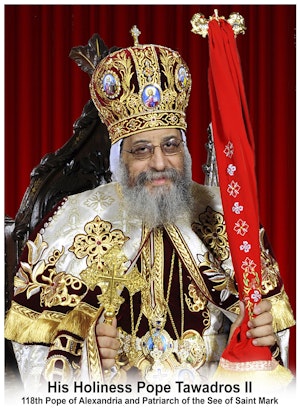
His Holiness Pope Tawadros II was born Wagih Sobhy Baky Soliman on November 4th, 1952 in Mansoura. His father was an irrigation engineer and his family moved around during his childhood from Mansoura to Sohag and then to Damanhour.He received his bachelor’s degree in pharmacy in 1975 from Alexandria University and earned a fellowship for the World Health Organization from the British International Health Institute in England in 1985. He attended the Coptic Seminary and graduated in 1983. He then worked as a manager in a pharmaceutical company in Damanhour that was owned by the Ministry of Health.
His Holiness’s life has always revolved around church since his youth; he wished to live the life of monasticism. He entered the Monastery of St. Pishoy in Wadi Elnatroun on August 20th, 1986 and remained a brother for two years. He was ordained a monk on July 31, 1988 and after a year he was ordained a priest on December 23, 1989. Two months after, H.H. Pope Tawadros started serving with H.E. Metropolitan Pakhomius of Beheira on February 15th, 1990. He was ordained a bishop on June 15th, 1997 by H.H. the Late Pope Shenouda III as a General Bishop assisting H.E. Metropolitan Pakhomius. His Holiness focused on childhood whether it was in the country-wide children’s festival as well when he was in charge of the children’s committee in the Holy Synod. Before assuming the papacy, H.H. wrote twelve books.
His Holiness was enthroned as the 118th Pope of Alexandria and Pope of the See of St. Mark on November 18th, 2012 at the Cathedral of St. Reweiss in Abbassiya, Cairo. The enthronement was presided by H.E. Metropolitan Pakhomius of Beheira, other metropolitans and bishops of the Coptic church and was attended by many delegates of Christian Churches.
The Diocese was officially established in 2013 by His Holiness Pope Tawadros II. The foundation of the Diocese was planted in the mid-1970s when numerous Coptic families emigrated to the United States from Egypt under the leadership and guidance of His Holiness Pope Shenouda III, the time came in 2013 for the official establishment of a Diocese under the auspices of His Grace Bishop David.
His Grace Bishop David was consecrated in formal ceremonies taking place in Cairo, Egypt on November 16-17, 2013. Bishop David was formally enthroned on December 7, 2013 at the Coptic Orthodox Church of St. Abraam in Woodbury, Long Island in a ceremony that brought together thousands of the Coptic faithful, clergy, and dignitaries.
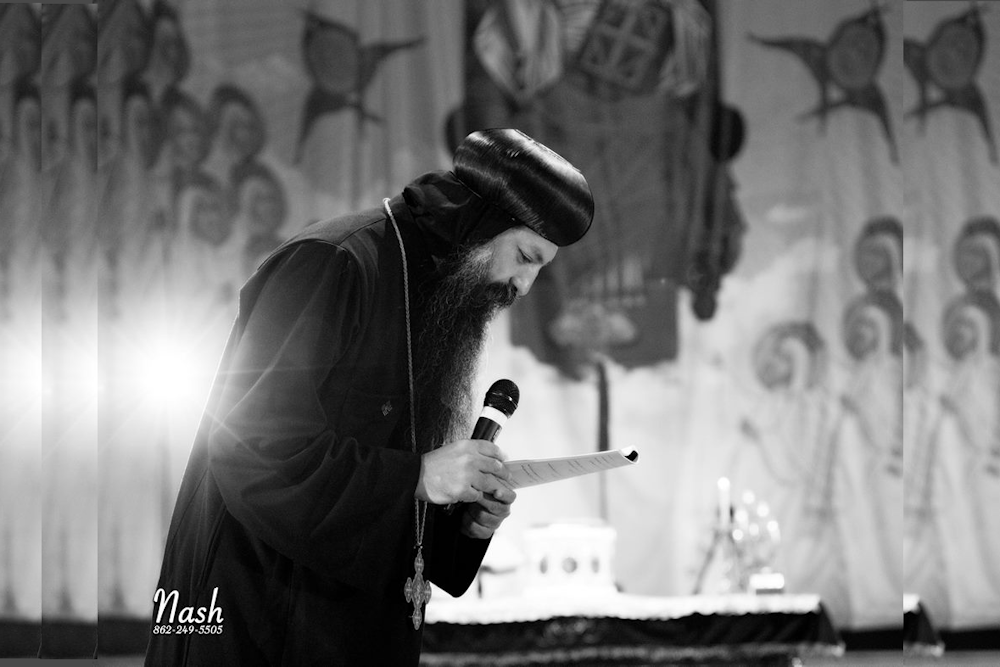
His Grace Bishop David was born on August 7, 1967 in Cairo, Egypt. In 1984, at the age of 17, he emigrated to Toronto, Canada with his family, where he attended York University. His Grace graduated from York with a Bachelor of Science degree in Biology in 1991.
In March 1992, His Grace joined St. Pishoy Monastery as a novice, and was ordained a monk on January 22, 1995. His Grace was ordained a priest on October 21, 1995 and served at the Diocese of Birmingham in the United Kingdom from November 1995 until November 1999. In November 1999, His Grace was ordained as a General Bishop by the Thrice-Blessed Pope Shenouda III of Blessed Memory. That month, His Grace was also appointed as the Patriarchal Exarch at the Archdiocese of North America in Cedar Grove, New Jersey and entrusted to oversee the papal residence and non-diocesan Coptic communities throughout North America. His Grace has since earned two Master’s Degrees, his first in Pastoral Counseling from Fordham University in New York in May 2010, and his most recent in Theological Studies from Holy Cross School of Theology in Boston in May 2013.
His Grace has represented the Coptic Orthodox Church in various conferences, including, most recently, the Assembly of the World Council of Churches in South Korea in October 2013. His Holiness Pope Tawadros II, with the Holy Synod of the Coptic Orthodox Church, consecrated His Grace as the first Shepherd and Diocesan Bishop of the newly formed Coptic Orthodox Diocese of New York and New England in formal ceremonies taking place in Cairo, Egypt on November 16-17, 2013.
The Christian School of Alexandria
The Christian school of Alexandria is the oldest Christian religion school in the world. The School of Alexandria started as a predominantly scientific and literary institution. It then developed into a philosophical and theological university.
The Catechetical School of Alexandria came in direct succession to it. The school was the most important institution for theological education in Christian antiquity. Its deans, teachers, and graduates were responsible for what could be called philosophizing of Christian Creed. They defined Christianity in its final form for all generations to come. The first known dean of the school was Pantaenus (died 190 AD), followed by Clement of Alexandria who made a real effort to successfully convert educated Greeks to Christianity. Next, came Origen (about 215 AD) who was a biblical scholar and philosopher. He wrote lengthy commentaries on almost every book in the Old and New Testaments. His homilies are known to be the most ancient example of Christian preaching. Origen was succeeded by Dionysius of Alexandria (The Great) who later became the Patriarch of the Church (246-264 AD).. Many bishops of the Christian Church, both in Egypt and abroad, were educated at the school under such great theologians as Clement, Origen (called the “Father of Theology”) and Didymus the Blind.
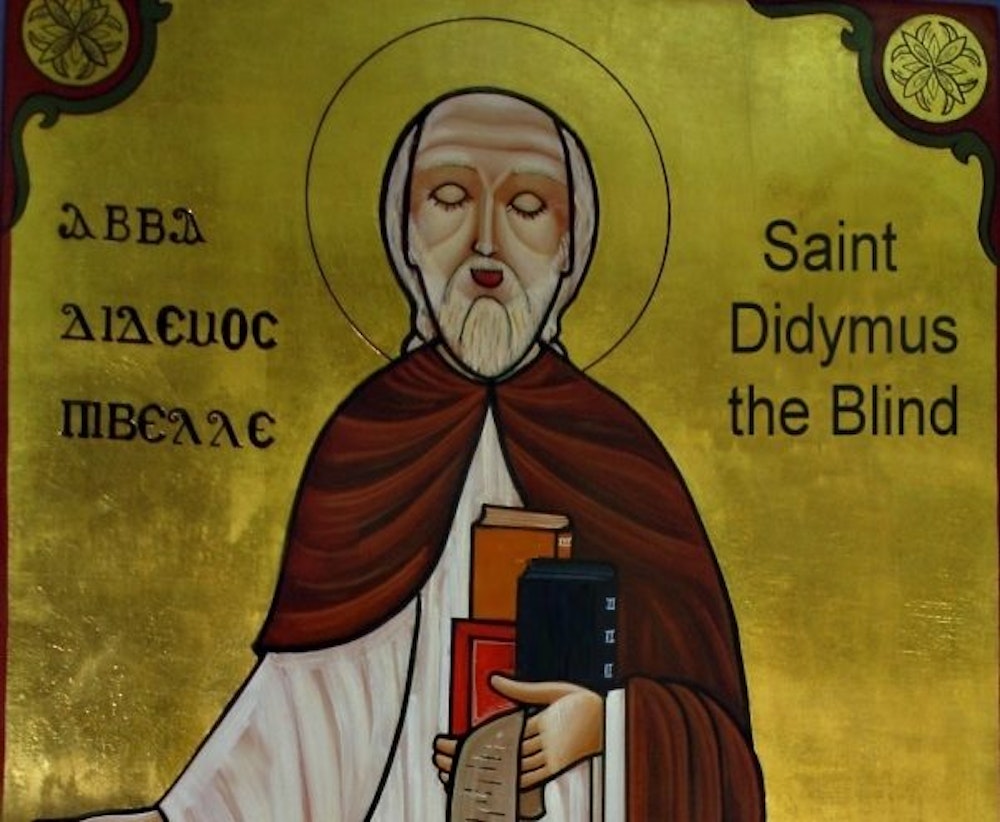
Under the supervision of Pantaenus and his assistant Clement the New Testament was translated from Aramaic and Greek into Coptic, the language of the Egyptian Christians. Didymus the Blind lost his sight when he was four years old. However, this handicap did not deter him from acquiring the vision of the mind and the soul. He mastered grammar, rhetoric, poetry, philosophy, mathematics and music. He knew by heart both the Old and the New Testaments. Among his pupils were St. Gregory Nazianzen, St. Jerome, Palladius and Rufinus the historian. In his care for educating the blind, he became the first one in history to devise a system of engraved writing, thanks to a raised-alphabet system using carved wood, fifteen centuries before Braille. Therefore even blind students were able to attend and learn. By the fourth century, Coptic Alexandria had indeed become the seat of Christian Learning for the whole world.
The Coptic Orthodox Church played an important part in the first three Ecumenical Councils, which convened to put a stop to heresies, to formulate the Orthodox and postolic creeds and doctrines, and to document the Apostolic canons of the Church. After the Council of Chalcedon, the Emperors of Constantinople ordered the closing of the school as part of their persecution against the Egyptian Christians. However, the Coptic Church simply transferred its school to the Monastery of St. Macarius in the Wadi el-Natroun desert. Then in 1893 the Theological College of the Catechetical School of Alexandria was re-founded and today has campuses in Cairo, New Jersey and Los Angeles.
The Holy Bible concentrates on “Jerusalem” which means, “land of peace,” or “vision of peace” as center of the Promised Land, where God declares His dwelling among people. And a holy temple was established in it in His Name, where people worshipped Him, offered Him sacrifices and offerings, and celebrated many feasts as a symbol of the heavenly joy. This is
Jerusalem, the symbol of heaven, that is called “Jerusalem above is free, which is the mother of us all” (Gal 4:26). On the other hand, we find Babel and Egypt; Babel represents disobedience to God, violence, vainglory (tower of Babel, Gen.11), opposing God through His believers (the Babylonian captivity), adultery and abominations (Rev. 17:5). Egypt was well known for its abundant cops, and its king (Pharaoh) to whom Israel and Jude used to refuge against Babylon. Therefore, Egypt was a symbol of loving the temporary things and trust in human hands (1 Kings 18:21).
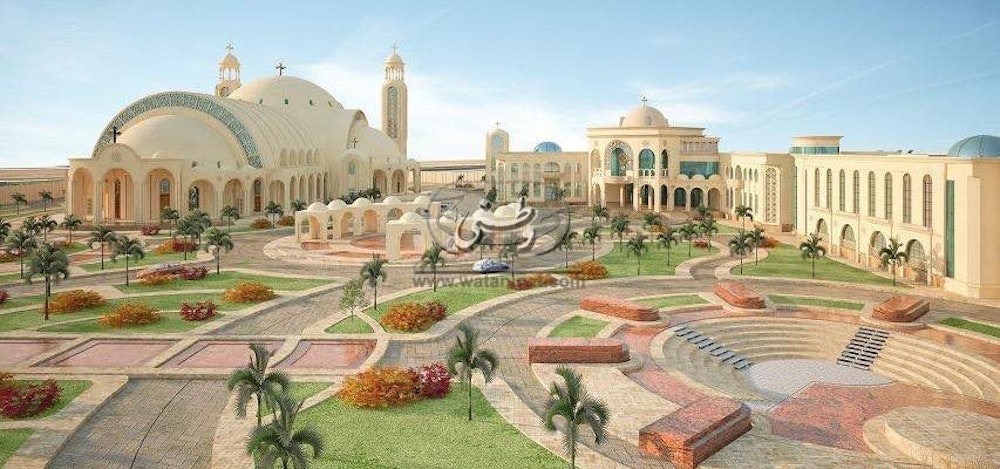
Egypt was a refuge to many people, especially in famines. Abraham visited Egypt (Gen. 12:10). So did Joseph who became the second man after Pharaoh, offering crops to all the neighboring countries. Jacob and his sons came to Egypt where they lived as a family and grew as a nation. It was the birth –place of the nursery of the people of God. Their first leader, Moses, the great prophet and his brother Aaron the first chief-priest appeared in Egypt to grant them freedom. St. Stephen says, “And Moses was taught in all the wisdom of the Egyptians, and was mighty in words and in deeds” (Acts 7:22).
Among the prophets who visited Egypt was Jeremiah who implored people not to flee to Egypt, but in vain, for they forced him to accompany them in their journey to Egypt (Jer. 41:1, 43:7). He uttered his last prophesies in Tahpanhes of Egypt (Jer. 43:8-44:30). Thus, Egypt became a representative of the Gentiles to whom Christ came to establish His Church and form His new people.
Blessed Be Egypt, My People
Hosea, the Prophet, foresaw the Son of God going out of Bethlehem and fleeing to Egypt, where He found a welcome in
the hearts of the Gentiles. Through Hosea, God the Father uttered this prophesy, “I called my son out of Egypt” (Hos. 11:1).
Isaiah the Prophet gave us more details, saying “Behold, the burden of Egypt, the Lord rides upon a swift cloud, He shall come to Egypt, and the idols of Egypt shall be moved at His presence. In that day there shall be an altar to the lord in the midst of the land of Egypt” (Isa. 19:1). St. Cyril the Great interpreted this prophecy saying: “The glittering cloud which carried the child Jesus to Egypt was His mother, St. Mary, who suppressed the cloud in purity. The altar which was established in the midst of the land of Egypt is the Christian church which had replaced the temples of paganism as the idols collapsed and the temples were deserted in the presence of the Lord Jesus.”
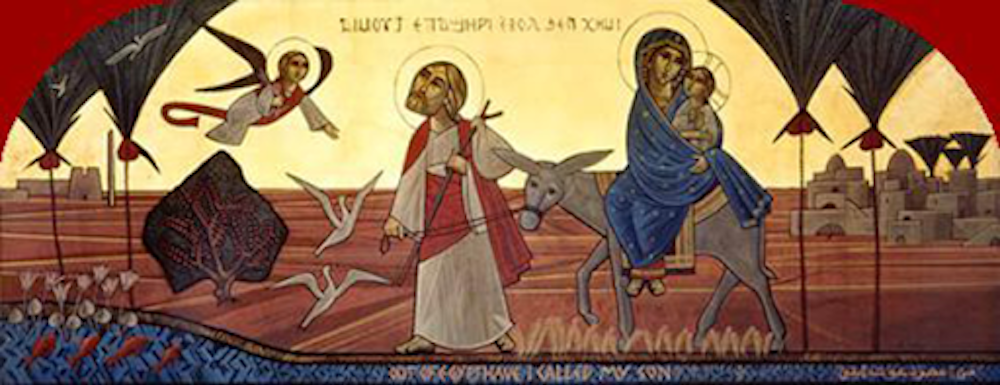
The Holy Family in Egypt
The Holy Family flight to Egypt, seeking refuge, is an event of the utmost significance in Egypt’s long history. It is
mentioned in the Holy Gospel of Matthew “And when they [the wise men from the east] were departed, behold the angel of the Lord appeareth to Joseph in a dream, saying, Arise, and take the young child and his mother, and flee into Egypt, and be thou there until I bring thee word; for Herod will seek the young Child to destroy Him. When he arose, he took the young Child and His mother by night and departed into Egypt; and was there until the death of Herod, that it might be fulfilled which was spoken of the Lord by the prophet, saying, Out of Egypt I called My Son” (Matt. 2:13-15).
Egypt was a logical place to find refuge, as it was outside the dominions of King Herod, but both Egypt and Palestine were part of the Roman Empire, making travel between them easy and relatively safe. The Holy family passed thru Greater Cairo, Old Cairo, Southern Cairo, and Upper Egypt during their flight.
It is believed that the Holy Family stayed in Egypt for a period of four years
The Copts feel very proud and fortunate to have the privilege of having the Lord Jesus’ footprints printed in their country and their hearts.
The Holy Sacraments
The Church’s Holy Sacraments
The Church Sacraments are sacred actions by which the believers receive invisible graces, through material or visible signs. The Coptic Church observes seven sacraments:
1. Sacrament of Baptism
The Sacrament of Baptism is the door by which the believer enters the church and has the right to partake in the rest of
the Sacraments. At Baptism, we are born again by being immersed in water three times in the name of the Holy Trinity; the Father, the Son and the Holy Spirit. The Lord Jesus Christ instituted the Sacrament of Baptism by being baptized by John the Baptist in the River Jordan, when the Holy Spirit came upon Him as a dove. Then, Jesus assured it after His resurrection when He said to His disciples: “Go therefore and make disciples of all nations, baptizing them in the name of the Father and of the Son and of the Holy Spirit” (Matthew: 28:19)
2. Sacrament of Confirmation
The Sacrament of Confirmation is also known as the Holy Anointment of
Myron. The word ‘Myron’ is a Greek word which means ‘ointment’ or ‘fragrant perfume’. The baptized person receives the Holy Myron immediately after Baptism, so as to become a temple of the Holy Spirit. The Baptized is anointed with 36 signs of the cross on his joints and senses so that the Holy Spirit can dwell within them. By this anointment, God grants the grace of confirmation to the baptized as well as the gifts of the Holy Spirit.
3. Sacrament of Confession and Repentance
The Sacrament of Repentance and Confession is a holy sacrament, by which the sinner returns to God, confessing his sins before the priest to be absolved by the priest through the authority granted to him by God. By this absolution, the confessing person is granted the forgiveness of those sins which he confessed.
4. Sacrament of Holy Eucharist
The Sacrament of Communion is a Holy Sacrament by which the believer eats the Holy Body and the Precious Blood of
Jesus Christ, presented by the Bread and Wine. This Sacrament has a special significance among the Seven Church sacraments. It is sometimes called the ‘Mystery of Mysteries’ or the ‘Crown of Sacraments’; for all the Sacraments are crowned by the Eucharist.
The Lord Jesus instituted the holy Eucharist on Covenant Thursday. After He celebrated the Rite of Passover of the Jews, He rose and washed the feet of His disciples, as a sign of repentance and preparation, then sat down and instituted the Passover of the New Covenant, which is the Sacrament of Holy Communion. “He took bread, blessed it and broke it, and gave it to the disciples and said, ‘Take, eat, this is My Body’, then He took the cup and gave thanks, and gave it to His disciples saying, ‘Drink from it, all of you, for this is My Blood of the New Covenant, which is shed for many for the remission of sins’” (Matthew 26:26-28)
5. Sacrament of the Unction of the Sick
The Sacrament of the Unction of the Sick is one of the holy Seven Sacraments of the church, through which the sick that
are faithful, are healed from psychological and physical diseases. The priest anoints the person with the holy oil from which they obtain the grace of remedy from God.
6. Sacrament of Holy Matrimony
Matrimony is a holy sacrament, officiated by a priest, of uniting a man to a
woman. Through this holy sacrament, the man and woman become one, for as the Lord Jesus said, “For this reason a man shall leave his father and mother and be joined to his wife and the two shall become one flesh. So then, they are no longer two but one flesh. Therefore what God has joined together, let not man separate” (Matthew 19:5, 6).
7. Sacrament of Priesthood
The Sacrament of Priesthood is a holy sacrament through which the
bishop lays his hands on the head of the elected candidate, so that the Holy Spirit will descend on him and grant him one of the priestly ranks. He is then given the authority to officiate the Sacraments of the church, doctrines, and others. The word ‘priest’ is derived from the Hebrew word ‘Kohen’, meaning priest, and is designated to members of the clergy.
The Divine Liturgy or Eucharist was the heart of the Christian worship and prayers in the early apostolic church and is still nowadays in all traditional and apostolic churches including the Coptic Orthodox church. In Latin, it is called “Liturgy”. “Eucharist” in Greek means “Thanksgiving”.
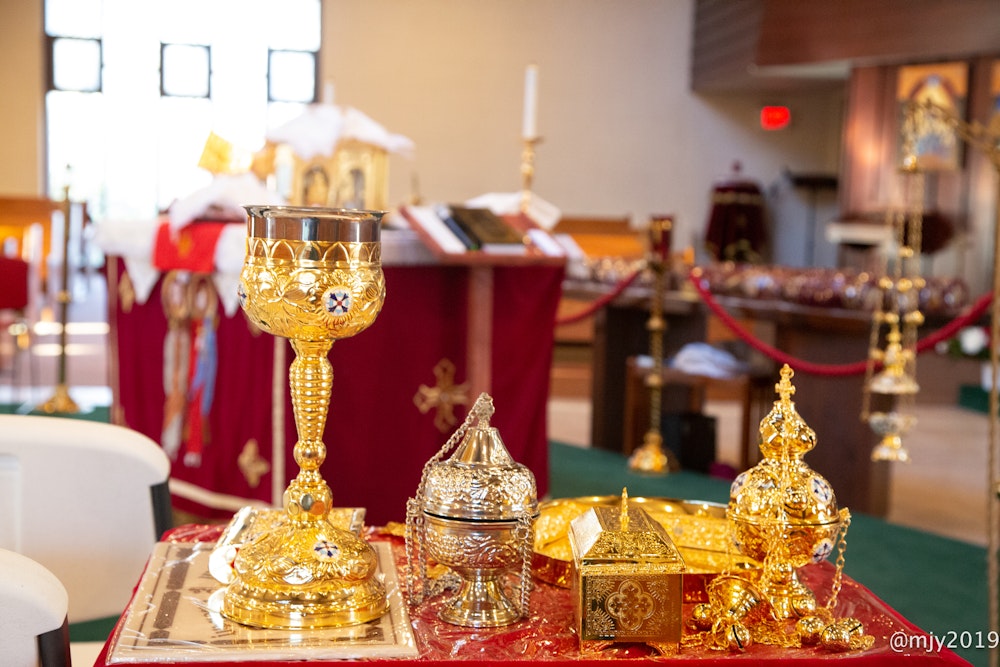
The Divine Liturgy is a New Testament sacrament instituted by the Lord Jesus Christ Himself before His passion as in the holy Gospels of St. Matthew 26, 26-29; St. Mark 14, 22-24; St. Luke 22, 19-23.
“And He took bread, gave thanks and broke it, and gave it to them, saying, ‘This is My body which is given for you; do this in remembrance of Me.’ Likewise He also took the cup after supper, saying, ‘This cup is the new covenant in My blood, which is shed for you’” (Luke 22:19-20).
About thirty years later, in his letter to Corinthians, St. Paul the Apostle mentioned this great sacrament: “For I received from the Lord that which I also delivered to you: that the Lord Jesus on the same night in which He was betrayed took bread; and when He had given thanks, He broke it and said, ‘Take, eat; this is My body which is broken for you; do this in remembrance of Me.’ In the same manner He also took the cup after supper, saying, ‘This cup is the new covenant in My blood. This do, as often as you drink it, in remembrance of Me.’ For as often as you eat this bread and drink this cup, you proclaim the Lord’s death till He comes” (Corinthians-1 11:23-26).
There are three main Liturgies in the Coptic Church:
1- THE LITURGY ACCORDING TO SAINT BASIL, BISHOP OF CAESAREA.
It is dedicated specially to the Person of the Omnipotent Father. It was established at the end of the fourth century. It is the one most commonly used in the Coptic Orthodox Church.
2- THE LITURGY ACCORDING TO SAINT GREGORY OF NAZIANZUS (THE THEOLOGIAN), BISHOP OF CONSTANTINOPLE.
It is dedicated to the Person of our Divine Redeemer. Our priests and bishops usually pray this Divine Liturgy in the great feasts of the church especially the Nativity, Epiphany and Resurrection feasts.
3- THE LITURGY ACCORDING TO SAINT CYRIL I, THE 24TH POPE OF THE COPTIC CHURCH.
It is dedicated to the Person of the Omnipotent Father. It is the Coptic version of the Greek Liturgy that was instituted by the Holy Apostle, St. Mark the Evangelist.
Monasticism was born in Egypt and was instrumental in the formation of the Coptic Church’s character of submission and humbleness. Thanks to the teachings and writings of the Great Fathers of Egypt’s Deserts. Monasticism began in the Coptic Church towards the end of the third century, and flourished in the fourth. By the end of the fourth century, there were hundreds of monasteries, and thousands of cells and caves scattered throughout the Egyptian hills. Many of these monasteries are still flourishing and have new vocations till this day.
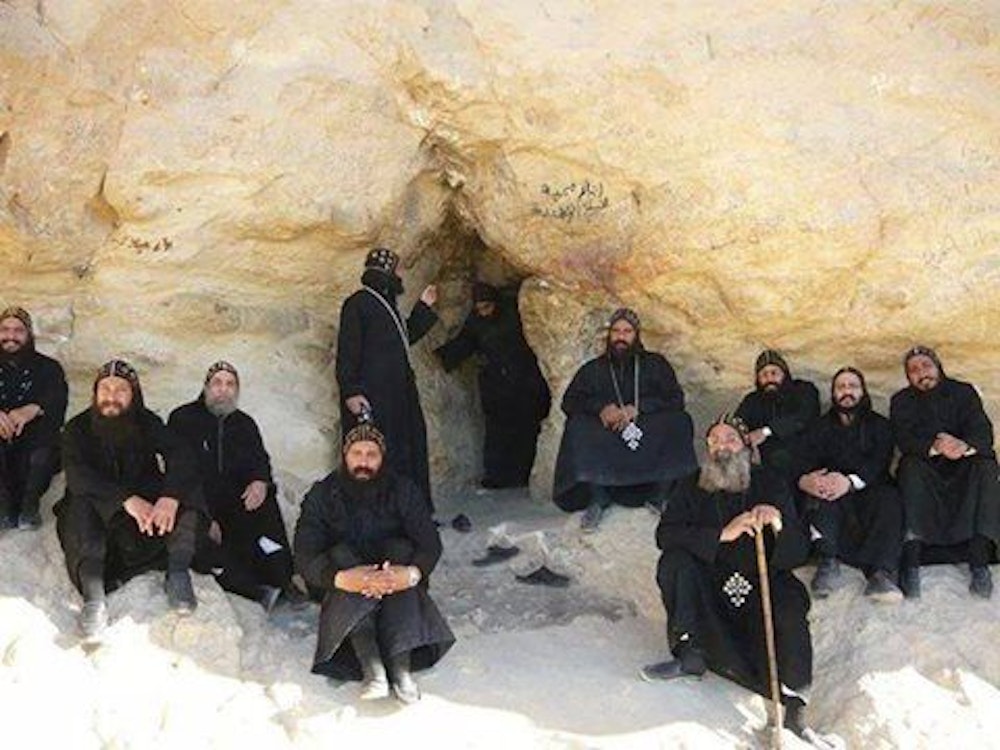
Saint Anthony, the world’s first Christian monk was a Copt from Upper Egypt. Saint Pachom, who established the rules of monasticism, was a Copt. And, Saint Paul, the world’s first anchorite is also a Copt. Other famous Coptic desert fathers include Saint Makarios, Saint Moses the Black, and Saint Mina the wondrous. Saint John Cassian said that the traveler from Alexandria in the north to Luxor in the south would have in his ears along the whole journey, the sounds of prayers and hymns of the monks, scattered in the desert, from the monasteries and from the caves, from monks, hermits and anchorites. For the monks, monasticism was the life of prayer, contemplation, solitude, worship and purity of heart. They had nothing in their minds, hearts and feelings except God alone. They lived the calm and quiet life abiding in the Lord, detaching themselves from everything and everyone, to be attached to Him alone. The more contemporary desert fathers include the late Pope Cyril VI and his disciple Bishop Mina Abba Mina.
Effects of Coptic Monasticism on the World
Coptic Monasticism is considered the most profound spiritual revival in the history of the Church. The news of the spiritual life of the monks spread everywhere. They did not write about themselves- there is no Coptic history about the Coptic monks. But people came from everywhere in order to hear a word from one of the monks, and to take it as a word of spiritual guidance and benefit throughout their life. Saint Palladius visited many monks and wrote his famous book, the `Paradise of the Fathers’, from which we learnt about these holy fathers, who neither spoke nor wrote, but kept silent. They were not preachers but they were living sermons, they were examples of the true life, they were the image of God on earth. They influenced monasticism in the world.
The Saints are dear members in the One Body of Christ who have struggled like us on earth and have departed to Paradise. They are not dead, but are sleeping, as St. Paul called them “But I do not want you to be ignorant, brethren, concerning those who have fallen asleep, lest you sorrow as others who have no hope.” (1 Thess 4:13).
The Saints in Paradise are the triumphant members of the same one church in which we are militant members. We, the triumphant and militants, are members of the Church, which is the one Body of our Lord Jesus Christ. They departed from earth, but did not leave the church; their love toward their brothers did not cease by their departure and dwelling in Paradise. The worship of Saints is expressly forbidden by the Church; however asking for their intercessions is central in any Coptic service. Their prayers for the salvation of the entire world never cease. They pray for us, and we honor them as they are our holy and dear friends.

Any Coptic Church is named after a Patron Saint. We esteem the icons of saints and put them on the iconostasis. Church walls and doors are hung with icons, also our homes, etc., as a sign of our communion with them in the Lord Jesus Christ.
Among all Saints, the Virgin Saint Mary (Theotokos) occupies a special place in the heart of all Copts. Other saints include martyrs like St. Mark, St. Mina, St. George, St. Mercurius (Known as Abu-sefein, or the one with two swords); monks like St. Anthony, St. Macarius, St. Bakhomious, Saints Maximus and Domitius, St. Moses the Black; Popes and bishops such as St. Athanasius the Apostolic, St. Dioscorus, St. Gregory, St. Cyril and many others.
Useful Links
- +1 203.455.7447
- +1 877.600.1006
- abouna@copts.org
- 20 Brookdale Rd, Stamford, CT 06903
©2023. St. Peter & St. Andrew Coptic Orthodox Church.. All Rights Reserved.

